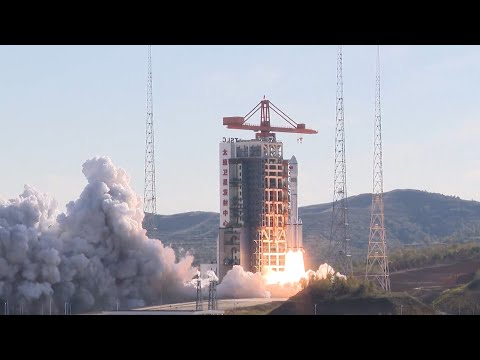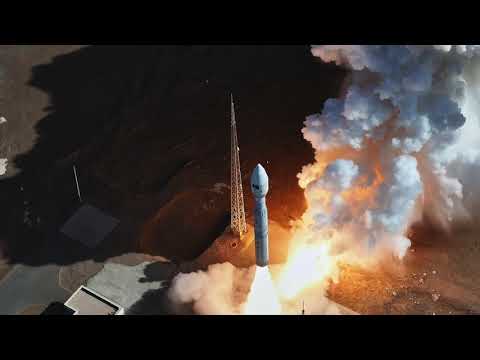HELSINKI — China conducted the first launch for the Thousand Sails constellation since March as the country continues its recent rapid rate of orbital launches.
A Long March 6A rocket lifted off at 3:08 a.m. Eastern, Friday, Oct. 17 (0708 UTC) from the Taiyuan Satellite Launch Center, north China. The China Aerospace Science and Technology Corporation (CASC) announced launch success, revealing the payloads to be Polar Group 18 for the Thousand Sails megaconstellation.
The flat panel satellites are part of the Thousand Sails megaconstellation to provide low Earth orbit internet services. The project is led by Shanghai Spacecom Satellite Technology (SSST), also known as Spacesail. The project is sometimes also referred to as Qianfan and G60 Starlink.
The number of satellites launched Friday was not explicitly stated, but 18 satellites were launched on each of the previous missions for the project, including four earlier Long March 6A launches. The satellites for Friday’s mission were provided by the Shanghai Engineering Center for Microsatellites (SECM), also known as Microsat.
The Long March 6A, which features a kerosene-liquid oxygen propellant core stage with solid propellant side boosters, is capable of launching 4,500 kilograms of payload to a 700-kilometer sun-synchronous orbit.
It is the sixth launch overall for Thousand Sails, following the first launch in August 2024, but the first such launch since March. While there are now 108 Thousand Sails satellites in orbit, statistics from space activity tracker Jonathan McDowell indicate that 14 satellites across these earlier launches have failed to raise their orbits, which are decaying. This includes 10 satellites from the second launch.
The launch for Spacesail was facilitated by CASC’s China Great Wall Industry Corporation (CGWIC), a company authorized by the Chinese government to provide satellites, commercial launch services and international space cooperation.
Meanwhile, Spacesail has awarded contracts for the launch of four batches of 10 satellites and a further three batches of 18 satellites, with the seven launches totaling 94 satellites, according to Chinese media reports, marking the first time commercial launch service providers are involved in the project.
The contracts were awarded to Landspace, Space Pioneer and CAS Space. The companies will likely use their new, yet-to-launch Zhuque-3, Tianlong-3 and Kinetica-2 launchers, which are all due to have test flights before the end of the year. The total price of the launches is $187 million. A similar tender process early this year failed due to insufficient bidders.
Kinetica-1 launch
Friday’s launch was followed by a commercial launch late Saturday Eastern. A CAS Space Kinetica-1 (Lijian-1) solid rocket lifted off at 11:33 p.m. Oct. 18 (0333 UTC, Oct. 19) from the Dongfeng Commercial Space Innovation Test Area at Jiuquan Satellite Launch Center, northwest China.
CAS Space announced launch success via its social media channels within an hour of liftoff, revealing the three satellites inserted into orbit to be the hyperspectral Pakistan remote sensing satellite (PRSS-2-HS1) and the AIRSAT 03 and 04 satellites.
It is the third remote sensing satellite launched this year by China for Pakistan, while the AIRSAT satellites are for Aerospace Information Research Institute of the Chinese Academy of Sciences (AIRCAS), a mixed ownership enterprise, building a synthetic aperture radar (SAR) constellation. The payload fairing indicates the involvement of Microsat and TerraX of Malaysia.
It was the ninth flight of the Kinetica-1 and the eighth successful flight, following an August launch carrying, among other payloads, a pair of femtosatellites for a Mexican company.
The success of “Mission Y8” also marks a total of 73 payloads and of over nine metric tons of payload delivered to orbit by Kinetica-1, CAS Space said via social media platform X. The Kinetica-1 has a take-off weight of 135 tons, a total length of 30 meters, a core stage diameter of 2.65 meters, a fairing diameter of 2.65 meters and can carry 1,500 kilograms of payload into a 500-kilometer sun-synchronous orbit, according to the Chinese Academy of Sciences. It uses SP70 solid rocket motors from state-owned space contractor CASC.
China’s 2025 launch activities
The launches were China’s 63rd and 64th of the year, with the country closing in on its national record of 68 launches in a calendar year, set in 2024. It follows the 12th launch for the Guowang megaconstellation Oct. 16 (UTC) which also marked the milestone 600th Long March rocket launch.
The next launch is expected to be a Long March 5 launch from Wenchang spaceport on Hainan island early eastern Oct. 22, with a Long March 3B launch to follow around Oct. 26 from Xichang, southwest China. The Shenzhou-21 crewed mission to the Tiangong space station is also expected to launch before the end of the month.
China is expected to carry out further tests for its crewed lunar program before the end of the year, while a number of commercial launch companies are racing to debut their new, larger launch vehicles.

